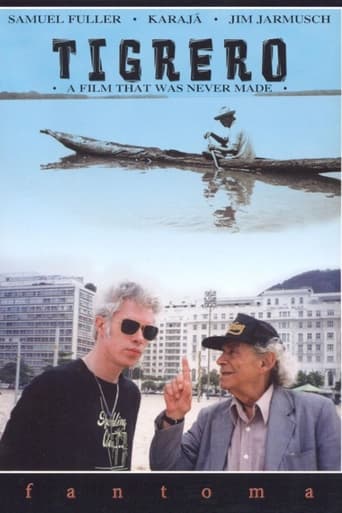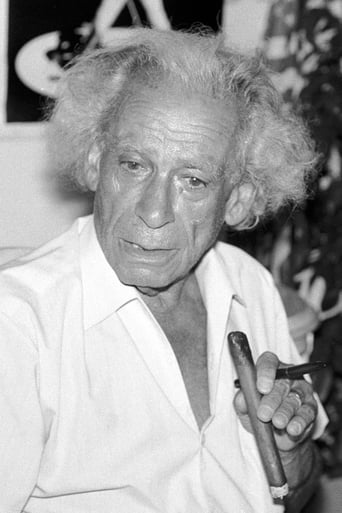Tigrero: A Film That Was Never Made (1994)
In 1993, Sam Fuller takes Jim Jarmusch on a trip into Brazil's Mato Grosso, up the River Araguaia to the village of Santa Isabel Do Morro, where 40 years before, Zanuck had sent Fuller to scout a location and write a script for a movie based on a tigrero, a jaguar hunter. Sam hopes to find people who remember him, and he takes film he shot in 1954. He's Rip Van Winkle, and, indeed, a great deal changed in the village. There are televisions, watches, and brick houses. But, the same Karajá culture awaits as well. He gathers the villagers to show his old film footage, and people recognize friends and relatives, thanking Fuller for momentarily bringing them back to life.
Watch Trailer
Free Trial Channels
Cast


Reviews
It really made me laugh, but for some moments I was tearing up because I could relate so much.
One of the most extraordinary films you will see this year. Take that as you want.
There are moments that feel comical, some horrific, and some downright inspiring but the tonal shifts hardly matter as the end results come to a film that's perfect for this time.
Actress is magnificent and exudes a hypnotic screen presence in this affecting drama.
An interesting documentary by Finnish filmmaker Mika Kaurismaki (brother of the more famous Aki). Filmed in the mid 1990s, it has Jim Jarmusch accompanying the legendary Samuel Fuller (who was in his early eighties by this time) to the Amazon forest to revisit the place where in the mid 1950s he planned to make a film. A film that, as the title says, was unfortunately never made. Fuller tells the story of the failed production. Tigrero, by the way, means a hunter of jaguars (which are called tigers in many parts of South America). Fuller says that John Wayne was going to play the role of the hunter in the movie, and Ava Gardner was set to co-star. It seems hard to believe that top Hollywood stars would be filming in a place that was back then (and still is) extremely remote, without any sort of modern facility. In fact, Fuller tells that one of the reasons the movie was never made was the difficulty of insuring the stars in such a potentially dangerous shooting. In many of the proposed settings for the film, the Kayapo Indians live, and it is interesting to get a glimpse of their lives. The movie is interesting, though perhaps of limited appeal (though you don't have to be a fan of Fuller or Jarmusch to enjoy this).
The image of hipster Jarmusch and Old-School Fuller wandering around like 2 characters in search of an epiphany was wacky enough. Place them in the middle of a Karaja village, with the amazing back-story of Fuller's flirtation with a jungle epic-that-never-was, and you've got a great little documentary that surpasses expectations--if in fact you had any. It's true that Jarmusch is absurdly out of place here, but that only ads to the surrealistic bent of the thing. And Fuller, a physical midget next to Jarmusch, is the one who is truly larger than life; a throwback to a time when directors truly dreamed and took action--the sort of character that Hollywood, in its increasing dependence on CGI, has conveniently squelched. We get to see a maverick, a dreamer, an egotist and a great observer of life in its myriad forms, who clearly loved every second of his time on this earth. The film is somewhat hampered by a lack of what a script man would call structure. And yet that didn't bother me because it was like watching a human circus unfolding: Here a Karaja ritual; there, Fuller fulminating about what coulda been, and everywhere around the amazing Mato Grosso, the real star of the story. Okay, it's no Aguirre, but if you love the process of film in its purest form, this is a terrific little flick.
Much like their fiction counterparts, documentaries rise and fall with their subject matter. If they are to be successful they must have a story worth telling. This one doesn't. In fact it wouldn't have been made to begin with if Sam Fuller wasn't such a cult icon for these two guys here, Jarmusch and Kaurismaki. In 1955 Sam Fuller was sent to the Matto Grosso jungle in Brazil by Zanuck of 20th Century Fox to gather material for an exotic adventure about an escaped convict woman, her husband and a bounty-hunter, the titular Tigrero. Wayne and Gardner were supposed to star, the film fell apart, apparently no insurance company was willing to take the risk of Wayne and Gardner shooting on location; but not before Fuller managed to shoot footage of the Indian tribe on 16mm. The footage, along with the script Fuller had prepared, languished for nearly 40 years. Fuller returned to the Indian tribe he once filmed, this time with Jim Jarmusch and Mika Kaurismäki, to shoot a documentary on a film that was never made.The major problem of Tigrero is that it is aimless and flaccid. It starts as a humorous travelogue of sorts then digresses in the traditions and customs of the Indian tribe which is only tangential at best and then finally arrives at what the box promised: anecdotal material provided by Fuller himself about the film. Fuller is such an interesting and lively character that he can almost sustain the film by himself, even when his stories are little more than small tidbits. On the other hand, his interviewer, Jarmusch, comes off as a self-conscious, humorless hipster, walking around the huts of the village in his cool Ramones tshirt and Rayban shades. Mika Kaurismäki's direction is average at best, mostly because he seems completely unprepared. There's no angle to the story to hook you with. Fuller's first travel through the Brazilian jungle, carrying with him a 16mm camera, film stock, a box of cigars and a Beretta, an adventure more interesting than the lurid, melodramatic subject of the movie he was supposed to be researching, isn't given its proper due. It's no wonder then that the most captivating scene in the movie, and the one that achieves any kind of emotional leverage, involves the indians watching the footage of their ancestors 40 years later.
I somewhat agree with the comments about the scripted components, but I don't think they really do any damage to the film.This docco has a lot of range, its tear jerkingly poignant in places, downright hilarious in others, and just astounding in others. The chief witchdoctors doing their elaborate ritual, fainly chanting 'Hollywood... Hollywood...' is a really transporting moment.The film definitely causes one to wonder about the future of the natives, whether they will go on as they have in their idyllic little universe.Strange thing is - I'm not actually that much of a Jim Jarmusch fan (yes I know he didn't direct this film but he would have had a lot of input), except for Dead Man which is a masterpiece. But this is a little gem.I recommend this film, its cute and beautiful.







